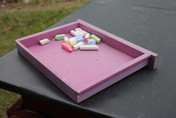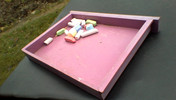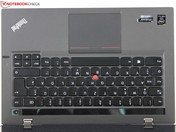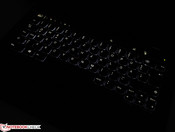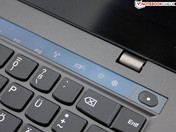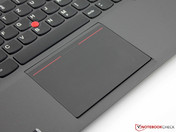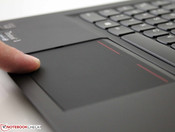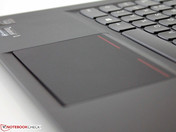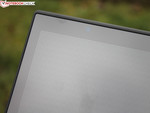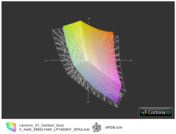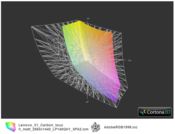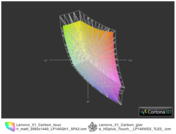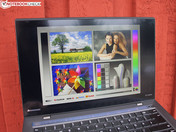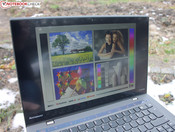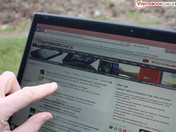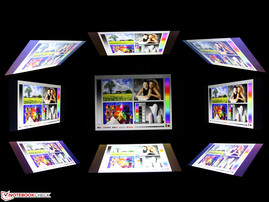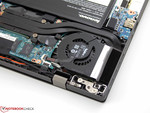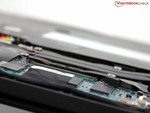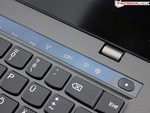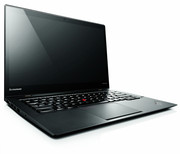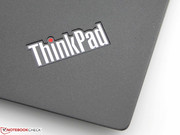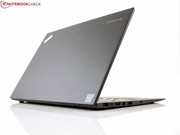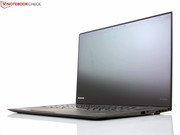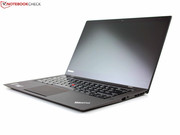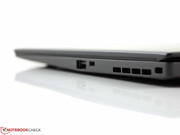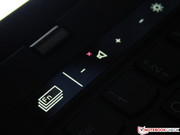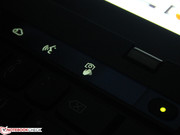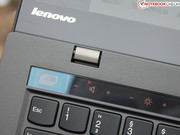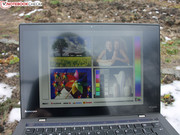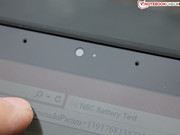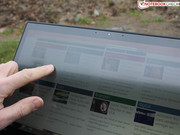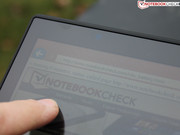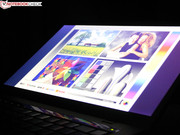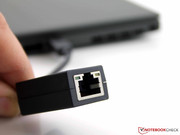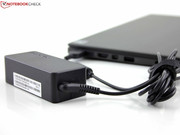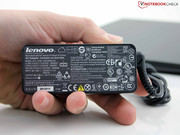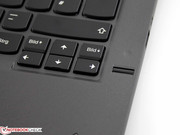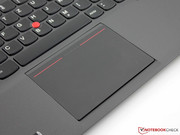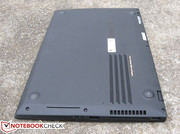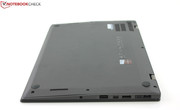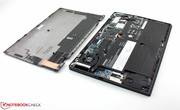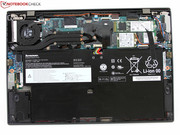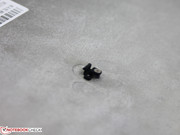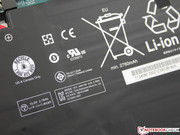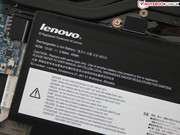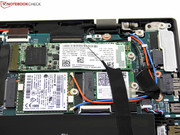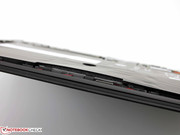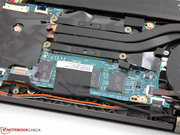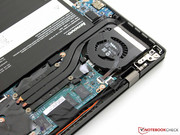Review Lenovo ThinkPad X1 Carbon Touch 20A8-003UGE Ultrabook

For the original German review, see here.
So how does one recognize a great business laptop? In 2013 one of our readers tended to prefer Lenovo's X1 Carbon, even though it may have very well been unaffordable for most as even the base configuration cost 1300 Euros (~$1782). Still, the Carbon was a brilliant manager's device when it came to aspects such as its input devices, its weight, its battery life and its performance. All of its weaknesses - the high amount of heat emissions under full load, the lack of a docking port (a huge connectivity issue for a business device) and the TN panel with its subpar viewing angles - have been tackled with the 2014 version. Whether successfully or not, our review will show.
Who are the main competitors? Actually, quite a few, all of them within the premium price segment. We will focus on those three competitors with the highest ratings (as marked in bold).
| 91% | Apple MacBook Pro Retina 13 inch Late 2013 | 13.3" | 2560x1600 | i5-4258U |
| 91% | Lenovo ThinkPad T440s | 14" | 1920x1080 | i7-4600U |
| 89% | Samsung ATIV Book 9 Plus 940X3G | 13.3" | 3200x1800 | i5-4200U |
| 85% | HP EliteBook Folio 9470m (HD+ optional) | 14" | 1366x768 | i5-3437U |
| 84% | Dell Latitude E7440 | 14" | 1920x1080 | i5-4300U |
| 81% | Fujitsu Lifebook U904 | 14" | 3200x1800 | i7-4600U |
| - | HP EliteBook Folio 1040 G1 - to be reviewed soon | 14" | 1600x900 | Haswell |
Case
The 2013 version offered a weight of just 1513 grams (non-touch version: 1347 grams; ~3.3 and 3.0 pounds respectively) while retaining great sturdiness. The high-quality materials cannot be experienced haptically by the user as the base unit, the area around the input devices and the lid feel like matte-painted plastics (and not metal-cold such as aluminum surfaces do). Still, it is far harder and more torsion-resistant than plastics would permit, despite a weight that has been reduced to a mere 1411 grams (~3.1 pounds).
Thanks to the matte, slightly rubberized surfaces (in all areas), the 14-inch device has a non-slip feel to it. Unfortunately, the torsion resistance of the lid and the base unit are not quite as good as with (noticeably heavier) aluminum unibodies (Apple MacBook Pro Retina 13, ATIV Book 9 Plus). Lifting the opened laptop at one edge leads to a slight distortion of the base unit. The same holds true for the lid: While the rear side is indeed highly pressure-resistant (even when applying pressure on a single point in the center), it can be distorted a bit to the sides.
To put this slight disadvantage into context: Those who rely on a perfectly torsion-resistant device will have to go with the higher weight of an aluminum unibody. Those who are blessed with the absence of kids who want to test out the lever rule, will be every bit as happy with magnesium, carbon fiber or a partial aluminum chassis (LifeBook, EliteBook Folio, ThinkPad T440s, Latitude E7440). Luckily, the X1 Carbon is far better than the rather un-sturdy carbon fiber laptop Vaio Pro 13 made by Sony - its 1066 grams (~2.4 pounds) may have been a bit too little.
Next to the optical changes concerning the chassis (touch bar above the keyboard, different ports), some details have been changed such as the position of the fingerprint sensor, the fan vents, the feet and the speakers. One major difference is the way of accessing the laptop's innards: Loosening a number of screws removes the new bottom panel (pictures of the innards on the right hand side) - this takes the place of having to take off the upper shell.
Connectivity
We have criticized the predecessor for its few ports: No docking port for an office-friendly docking station, no VGA, no HDMI and no Ethernet RJ45. The 2014 version now comes with the much-missed OneLink dock connector for the well-known docking station, which works with all new S- and E-series ThinkPads and even the budget office device B5400. Moreover, while the port replicator may not include any additional ports, it does at least make it more comfortable to unplug the device. The airplane mode switch is gone, but it has been replaced by a small port for the Ethernet dongle (included!) and an HDMI port. Unfortunately, no SD card reader has been included.
Communication
Instead of a Centrino Advanced-N 6205s, the new Carbon X1 comes with an Intel Wireless-AC 7260 Wi-Fi modem including Bluetooth 4.0. During our (unscientific) range check, the device quickly lost half of its signal strength (down to 2-3 bars) at a distance of approximately 15 meters (~49 feet), completely losing the connection to our router (Fritz!Box 7270 @100%). On the other hand, the ProBook 640 G1 (Broadcom BCM943228HM4L 2x2 WiFi) for example, retains the connection even at a distance of 45 meters (~148 feet; browsing still possible). The limited range of AC Wi-Fi modems when compared to older models had already been noted during our reviews of the Asus Transformer Book Trio TX201LA, the Medion Akoya P2211T Test Medion Akoya P2211T MD98602 Convertible (both Wireless-AC 3160) and the Dell XPS 12 as well as the Sony Vaio Pro 13 (both Wireless-AC 7260). The integrated HSPA+ ThinkPad Ericsson N5321 Mobile Broadband modem uses an M.2 slot just as the Wi-Fi module, yielding cellular connections.
Security
A professional work environment demands a lot more in terms of security features and the ThinkPad X1 delivers: An integrated TPM module, a fingerprint sensor (now in a better location than right beneath the arrow keys), hard drive encryption, Intel's Anti-Theft/Computrace solution, a USB / BIOS connection lock and a number of BIOS settings concerning hardware functions and security (as can be seen in the following screenshots) are included, as is a password manager software.
Maintenance
Accessibility has been improved noticeably: Lifting the bottom panel (which is fastened with a number of screws), as shown on the right hand side, allows access to the innards. While the onboard RAM module can neither be replaced nor augmented (it is soldered to the mainboard, as is the CPU), at least the fan can easily be cleaned. All communication modules are plug-in M.2 cards (Wi-Fi, HSPA+, SSD). The battery comes with a capacity of 45 Wh. It is also fastened with a number of screws and can thus be replaced.
Software
QuickCast, Skitch Touch, Solution Center, QuickControl, User Guide and MS Office 365 Trial come preinstalled. In addition, more than 70 entries can be found in the program list under the system control center, including a number of driver packages and hardware-specific tools (e.g. Intel Smart Connect, Intel Management and Security).
Accessories
A Gigabit dongle (Intel I218-LM) is included, yielding wire-based Ethernet network connections via a proprietary Lenovo port.
Warranty
All models of the ThinkPad X1 Carbon (2014 20A7005RGE) listed in German online shops come with three years of on-site service, with optional warranty extensions to up to five years being available (ThinkPlus service, 169 Euros (~$232) extra). Even accidental damage insurances (shocks, falls, liquids etc.) are available.
Input Devices
Keyboard
The conventional section of the keys has seen a number of improvements, but this time in terms of the layout (the superb mechanical properties of the 2013 edition - from key travel to pressure point, bulges and conical shape - remain the same) which may very well be considered "too experimental" by some traditionalists. The function and F keys have been removed completely; no extra keys above the keyboard itself remain. Thus, Esc, Pos1, End, Ins and Del had to be moved as well. Pos1 and End replace the old Caps Lock key at the left (which is gone without replacement, a decision some typists may even cherish). Insert has been omitted as well, Delete takes up part of the old Backspace key - this is actually the biggest issue when it comes to involuntary typos.
Touchpad
The touchpad has seen some changes as well. It is now 70 x 100 mm large (~2.8 x 3.9 inches), with the two touchpad buttons having been removed, at least physically. Still, the click zones have remained the same as before. The touchpad offers a generous 2 mm of travel, with even responsiveness throughout (while many consumer touchpads offer no travel at all in their upper third). Lenovo calls this a glass surface, but while the matte surface feels hard and premium due to its non-glossy coating, it does not feel cool. It works flawlessly, allowing for quick and responsive reactions of the device. Many professional users will prefer the red TrackPoint, but some of them are going to miss the real, physical buttons, as they felt a bit faster and more responsive than the touchpad of the 2014 edition.
Touch Panel
Our X1 Carbon comes with a 10-finger multi-touch screen. This is not the standard as there is also a non-touch variant 20A7005MGE (Core i5, 180 GB SSD). Both screens are matte, an effect that is achieved in the case of our device with a film on top of the glass. While this is not quite enough to remove all fingerprints, it does reduce reflections by a highly significant amount. The grid of the capacitive touch layer is visible even to the naked eye. The screen remains sensitive right up to its edges. Everything works reliably and flawlessly, with quick response times thanks to the high performance of the SSD and i7-powered device.
Gesture Control
Lenovo seems to be quite proud of its webcam-based gesture system called Gesture Control where simple movements of the hand are translated into simple commands such as going to the next slide, adjusting music volume and stopping or starting music playback. All of this works rather well when the hand is 0.5 to 2 meters (~1.6 to 6.6 feet) away from the webcam, and with a number of common programs which support this feature, such as Windows Media Player, Adobe PDF Reader or Power Point. Our verdict after our tests: A nice idea, but users should practice before they rely too much on it during a presentation.
Touch Bar
Lenovo calls its replacement for the F keys an "Adaptive Keyboard". It is a touch-sensitive bar with backlighting capable of displaying five different modes. One of these comes close to the original function mode with the F keys; another one is called a "web conference mode". This includes volume and microphone controls as well as shortcuts for adjusting brightness as well as turning the webcam, the gesture control system and the voice control on (or off). More details about the keys of all five modes can be found below in our screenshots. The order of the modes can be adjusted, as can be the allocation of a certain mode to a certain application ("dynamic mode"). New symbols cannot be added, as this is no LCD, just a number of backlit keys with the same symbol always appearing at the same location.
In order to appease users of shortcuts, some (unlabeled) Fn key combinations do work by pressing the Fn touch symbol and a certain letter (or number) at the same time, as can be seen below. Fn+4, for example, activates the standby mode of the X1.
Display
Lenovo improves upon the major disadvantage of the old X1 Carbon, equipping the 2014 version with a 14-inch WQHD screen with 2560x1440 pixels instead of the HD+ screen with its 1600x900 pixels, boosting the pixel density from 131 ppi to 210 ppi. Whether this is worth the extra money (not all variants of the 2014 edition come with this screen) has to be decided by the user. Even more importantly, though, Lenovo has finally replaced the TN panel with an IPS screen so that the new WQHD IPS is definitely a major improvement in terms of contrast ratio and viewing angle stability.
The Carbon is not the only laptop with such a high resolution. The Dell Latitude E7440 can be had with 1920x1080 pixels. Samsung's ATIV Book 9 Plus even manages to pack 3200x1800 pixels into just 13.3 inches. The Apple MacBook Pro Retina 13 offers 2560x1440 pixels, not too far behind the Fujitsu LifeBook U904 with its 3200x1800 pixels. Even Lenovo's ThinkPad T440s now comes with 1920x1080 pixels.
| |||||||||||||||||||||||||
Brightness Distribution: 87 %
Center on Battery: 253 cd/m²
Contrast: 1434:1 (Black: 0.175 cd/m²)
ΔE ColorChecker Calman: 5.81 | ∀{0.5-29.43 Ø4.78}
ΔE Greyscale Calman: 6.23 | ∀{0.09-98 Ø5}
50% AdobeRGB 1998 (Argyll 1.6.3 3D)
52.5% AdobeRGB 1998 (Argyll 3D)
74.3% sRGB (Argyll 3D)
51.5% Display P3 (Argyll 3D)
Gamma: 2.22
CCT: 5604 K
| Lenovo ThinkPad X1 Carbon Touch 20A8-003UGE HD Graphics 4400, 4600U, Intel SSD Pro 1500 Series SSDSCKHF240A4 | Lenovo Thinkpad T440s 20AQ0069GE HD Graphics 4400, 4600U, Samsung SSD 840 250GB MZ7TD2560/0L9 | Samsung ATIV Book 9 Plus HD Graphics 4400, 4200U, Samsung MZNTD128HAGM | Dell Latitude E7440 FHD SSD256 HD Graphics 4400, 4300U, Liteonit LMT-256M6M | Fujitsu Lifebook U904 HD Graphics 4400, 4600U, Toshiba HG5d THNSNH256GCST | |
|---|---|---|---|---|---|
| Display | 28% | 19% | 30% | ||
| Display P3 Coverage (%) | 51.5 | 66.9 30% | 65.2 27% | 66.9 30% | |
| sRGB Coverage (%) | 74.3 | 92.8 25% | 83.7 13% | 96.5 30% | |
| AdobeRGB 1998 Coverage (%) | 52.5 | 67.8 29% | 60.9 16% | 68.3 30% | |
| Screen | -7% | -9% | 9% | 9% | |
| Brightness middle (cd/m²) | 251 | 310 24% | 301 20% | 318 27% | 317 26% |
| Brightness (cd/m²) | 252 | 282 12% | 284 13% | 304 21% | 306 21% |
| Brightness Distribution (%) | 87 | 85 -2% | 84 -3% | 92 6% | 90 3% |
| Black Level * (cd/m²) | 0.175 | 0.38 -117% | 0.39 -123% | 0.24 -37% | 0.25 -43% |
| Contrast (:1) | 1434 | 816 -43% | 772 -46% | 1325 -8% | 1268 -12% |
| Colorchecker dE 2000 * | 5.81 | 4.56 22% | 4 31% | 4.29 26% | 4.17 28% |
| Greyscale dE 2000 * | 6.23 | 5.12 18% | 4.4 29% | 4.68 25% | 4.87 22% |
| Gamma | 2.22 99% | 2.66 83% | 2.43 91% | 2.69 82% | 2.45 90% |
| CCT | 5604 116% | 6116 106% | 7434 87% | 6131 106% | 6792 96% |
| Color Space (Percent of AdobeRGB 1998) (%) | 50 | 64 28% | 54.8 10% | 64.5 29% | |
| Total Average (Program / Settings) | 11% /
2% | -9% /
-9% | 14% /
12% | 20% /
15% |
* ... smaller is better
A contrast ratio of 1434:1 is much more than that of most of its competitors, with only the Latitude E7440 (Full HD version) and the LifeBook U904 exceeding a factor of 1000:1 as well. The brightness, on the other hand, is just average at 252 cd/m², but it does at least remain constant while running on battery. As is the case with its competitors, color space coverage is mediocre, with just 50% of the Adobe color space and 74% of sRGB. The only exception is the U904, which reaches 64% of the Adobe color space.
The exact color reproduction can be tested before and after calibration with a color spectrometer (the values in the charts are prior to calibration). The X1 does not manage to reach the target value of DeltaE smaller than 3, but neither does its competitors (neither for the grayscale rendition nor for the colors themselves). A calibration does not do much: The grayscale DeltaE value decreases to 4, that of the colors to 4.3. The warmish appearance of the bright grays can even be noted with the naked eye. The saturation sweeps show that the largest deviations occur for greens and reds, and calibration does little to correct it.
Thanks to its matte film and the non-diminished brightness while running on battery, the laptop can be used easily outdoors. The anti-glare film helps in reducing (but not eliminating) reflections, yielding the ideal compromise between touch support and outdoor usability. While it does not come close to matte, non-touch office laptops, it works almost flawlessly under cloudy skies.
Unsurprisingly, the viewing angle stability of the WQHD Carbon (2014) is much better than that of the HD+ X1 Carbon (2013) as can be seen below, with no color inversions occurring. The overexposure of the lower three images is due to the shooting - a user would see normal colors.
Performance
Our test device ships with an Intel Core i7-4600U (2.1 to 3.3 GHz) and thus also an integrated Intel HD Graphics 4400 GPU. In addition, a 240 GB SSD (approx. 160 GB remain available for the user) and 8 GB of (onboard) RAM have been included. Other configurations with an Intel Core i5-4200U, an i7-4550U or a 180 GB SSD do exist. The cheapest configuration can be had for 1635 Euros (~$2242), being equipped with the WQHD panel (2560x1440 pixels). While the HD+ version might be cheaper, it is not yet available in Germany.
Processor
We are employing Cinebench R15 in order to determine the CPU and GPU clock speeds during normal loads (no stress test), checking how well the Turbo Boost works. A decent cooling system allows the CPU to at least keep its base clock speed of 2.1 GHz (i7-4600). And in an ideal world, the full Turbo clock speed of 3.3 GHz is upheld indefinitely.
The clock speed during our multi tests was close to a constant level of 2.4 GHz (including the Turbo range), but this leads to just 170 points, 26% less than those of the Fujitsu LifeBook U904 (same CPU, same slightly-turbo-y clock speeds). This strange difference is retained during Cinebench R11.5 multi (U904: +36%) as well as during the computation sub score of the PCMark 7 (as seen below) with a difference of 88% between the LifeBook U904 and the X1.
The (alternatively available) Core i5-4200U, as used in the ATIV Book 9 Plus and the ThinkPad T440s, fares a lot better (~ 30%), but this does not have much to say about how such a CPU would perform in the X1, as similar performance drops might occur.
While running on battery, even less performance can be had, with the R11.5 test results (including OpenGL via GPU) yielding 1.64 (multi, instead of 1.9) and 14.52 (OpenGL, instead of 15.93) points with the high-performance profile being active.
| Cinebench R15 | |
| CPU Single 64Bit (sort by value) | |
| Lenovo ThinkPad X1 Carbon Touch 20A8-003UGE | |
| Samsung ATIV Book 9 Plus | |
| Apple MacBook Pro Retina 13 inch 2013-10 | |
| CPU Multi 64Bit (sort by value) | |
| Lenovo ThinkPad X1 Carbon Touch 20A8-003UGE | |
| Samsung ATIV Book 9 Plus | |
| Apple MacBook Pro Retina 13 inch 2013-10 | |
| Fujitsu Lifebook U904 | |
| OpenGL 64Bit (sort by value) | |
| Samsung ATIV Book 9 Plus | |
| Cinebench R11.5 | |
| CPU Single 64Bit (sort by value) | |
| Lenovo ThinkPad X1 Carbon Touch 20A8-003UGE | |
| Samsung ATIV Book 9 Plus | |
| Apple MacBook Pro Retina 13 inch 2013-10 | |
| Lenovo ThinkPad T440s 20AQ-S00500 | |
| HP EliteBook Folio 9470m H4P04EA | |
| CPU Multi 64Bit (sort by value) | |
| Lenovo ThinkPad X1 Carbon Touch 20A8-003UGE | |
| Samsung ATIV Book 9 Plus | |
| Apple MacBook Pro Retina 13 inch 2013-10 | |
| Lenovo ThinkPad T440s 20AQ-S00500 | |
| Fujitsu Lifebook U904 | |
| HP EliteBook Folio 9470m H4P04EA | |
| OpenGL 64Bit (sort by value) | |
| Lenovo ThinkPad X1 Carbon Touch 20A8-003UGE | |
| Samsung ATIV Book 9 Plus | |
| Apple MacBook Pro Retina 13 inch 2013-10 | |
| Lenovo ThinkPad T440s 20AQ-S00500 | |
| Fujitsu Lifebook U904 | |
| HP EliteBook Folio 9470m H4P04EA | |
System Performance
PCMark results are similar: Despite the great SSD of the X1 (see below) which takes the lead together with the LifeBook U904 and the MacBook Pro Retina 13, the PCMark 7 result of just 3015 points is quite a disappointment. Its competitors are up to 81% faster, including once again Fujitsu LifeBook U904 (+60%). The productivity sub score is just as bad. PCMark 8 is not really comparable as no v2 score is available for the older tests. Thus, here only the Dell Latitude E7440 (Full HD version) with its i5-4300U remains, which - without PCMark 7 scores - takes the lead by a mere 5%, much less than before.
A CAD tool test, SpecViewPerf 11.0, leads to another disappointment: An integrated GPU such as the HD 4400 is just not the right tool for these applications, even if it is running as smoothly as with the ProBook 430-G1.
But while the benchmark results appear mediocre, the actual user experience is just great, with boot times (up to entering one's password) of just 6 seconds, near-instantaneous wake-up times from standby, fast installations and quick app starts. Then again, this is exactly what we expect from a device with a price point of around 2000 Euros (~$2742).
| PCMark 7 | |
| Score (sort by value) | |
| Lenovo ThinkPad X1 Carbon Touch 20A8-003UGE | |
| Lenovo ThinkPad T440s 20AQ-S00500 | |
| HP EliteBook Folio 9470m H4P04EA | |
| Samsung ATIV Book 9 Plus | |
| Fujitsu Lifebook U904 | |
| Apple MacBook Pro Retina 13 inch 2013-10 | |
| Productivity (sort by value) | |
| Lenovo ThinkPad X1 Carbon Touch 20A8-003UGE | |
| Lenovo ThinkPad T440s 20AQ-S00500 | |
| HP EliteBook Folio 9470m H4P04EA | |
| Samsung ATIV Book 9 Plus | |
| Fujitsu Lifebook U904 | |
| Apple MacBook Pro Retina 13 inch 2013-10 | |
| Computation (sort by value) | |
| Lenovo ThinkPad X1 Carbon Touch 20A8-003UGE | |
| Lenovo ThinkPad T440s 20AQ-S00500 | |
| HP EliteBook Folio 9470m H4P04EA | |
| Samsung ATIV Book 9 Plus | |
| Fujitsu Lifebook U904 | |
| Apple MacBook Pro Retina 13 inch 2013-10 | |
| System Storage (sort by value) | |
| Lenovo ThinkPad X1 Carbon Touch 20A8-003UGE | |
| Lenovo ThinkPad T440s 20AQ-S00500 | |
| HP EliteBook Folio 9470m H4P04EA | |
| Samsung ATIV Book 9 Plus | |
| Fujitsu Lifebook U904 | |
| Apple MacBook Pro Retina 13 inch 2013-10 | |
| PCMark 8 | |
| Work Score Accelerated v2 (sort by value) | |
| Lenovo ThinkPad X1 Carbon Touch 20A8-003UGE | |
| Dell Latitude E7440 FHD SSD256 | |
| Storage Score (sort by value) | |
| Lenovo ThinkPad X1 Carbon Touch 20A8-003UGE | |
| Samsung ATIV Book 9 Plus | |
| Fujitsu Lifebook U904 | |
| Apple MacBook Pro Retina 13 inch 2013-10 | |
| PCMark 7 Score | 3015 points | |
| PCMark 8 Home Score Accelerated v2 | 2264 points | |
| PCMark 8 Creative Score Accelerated v2 | 2672 points | |
| PCMark 8 Work Score Accelerated v2 | 3139 points | |
Help | ||
| Lenovo ThinkPad X1 Carbon Touch 20A8-003UGE HD Graphics 4400, 4600U, Intel SSD Pro 1500 Series SSDSCKHF240A4 | Fujitsu Lifebook U904 HD Graphics 4400, 4600U, Toshiba HG5d THNSNH256GCST | HP ProBook 430-G1 HD Graphics 4400, 4200U, Hitachi Travelstar Z5K500 HTS545050A7E380 | HP ZBook 15 Quadro K2100M, 4700MQ, Hitachi Travelstar 7K750 HTS727575A9E | |
|---|---|---|---|---|
| SPECviewperf 11 | -8% | 25% | 1252% | |
| 1920x1080 Catia (fps) | 42.11 | |||
| 1920x1080 Ensight (fps) | 1.58 | 1.29 -18% | 1.94 23% | 28.25 1688% |
| 1920x1080 Lightwave (fps) | 10.81 | 9.88 -9% | 12.52 16% | 48.97 353% |
| 1920x1080 Maya (fps) | 10.69 | 7.81 -27% | 10.22 -4% | 52.8 394% |
| 1920x1080 Pro/ENGINEER (fps) | 1.39 | 1.72 24% | 1.73 24% | 17.6 1166% |
| 1920x1080 SolidWorks (fps) | 6.77 | 6.04 -11% | 9.11 35% | 42.39 526% |
| 1920x1080 Tcvis (fps) | 1.62 | 1.47 -9% | 2.21 36% | 34.27 2015% |
| 1920x1080 Siemens NX (fps) | 1.15 | 1.06 -8% | 1.68 46% | 31.34 2625% |
Mass Storage
The Intel SSD Pro 1500 SSDSCKHF240A4 with its 240 GB gross capacity offers superb read and write speeds during our 4K tests. Almost 40 MB/s? None of its competitors reach these levels. The SSD also takes the top spot in terms of Write 4K speeds of 106 MB/s. The less relevant Read Sequential test still yields above-average results, but in this regard, most high-end SSDs come to lie close to each other anyway.
| CrystalDiskMark 3.0 | |
| Read 4k (sort by value) | |
| Lenovo ThinkPad X1 Carbon Touch 20A8-003UGE | |
| Dell Latitude E7440 FHD SSD256 | |
| Samsung ATIV Book 9 Plus | |
| Apple MacBook Pro Retina 13 inch 2013-10 | |
| Fujitsu Lifebook U904 | |
| HP EliteBook Folio 9470m H4P04EA | |
| Write 4k (sort by value) | |
| Lenovo ThinkPad X1 Carbon Touch 20A8-003UGE | |
| Dell Latitude E7440 FHD SSD256 | |
| Samsung ATIV Book 9 Plus | |
| Apple MacBook Pro Retina 13 inch 2013-10 | |
| Fujitsu Lifebook U904 | |
| HP EliteBook Folio 9470m H4P04EA | |
| Write Seq (sort by value) | |
| Lenovo ThinkPad X1 Carbon Touch 20A8-003UGE | |
| Dell Latitude E7440 FHD SSD256 | |
| Samsung ATIV Book 9 Plus | |
| Apple MacBook Pro Retina 13 inch 2013-10 | |
| Fujitsu Lifebook U904 | |
| HP EliteBook Folio 9470m H4P04EA | |
| Read Seq (sort by value) | |
| Lenovo ThinkPad X1 Carbon Touch 20A8-003UGE | |
| Dell Latitude E7440 FHD SSD256 | |
| Samsung ATIV Book 9 Plus | |
| Apple MacBook Pro Retina 13 inch 2013-10 | |
| Fujitsu Lifebook U904 | |
| HP EliteBook Folio 9470m H4P04EA | |
Graphics Card
Contrary to our pure CPU results, the OpenGL test of our GPU actually yielded above-average results, on par with the Samsung ATIV Book 9 Plus (which is just 3% faster). The Fujitsu LifeBook U904 (all ship with an HD 4400) was weaker by 17% due to its Single Channel RAM (while the GPU of the X1 profits from its Dual Channel RAM). The variable GPU clock speed hovers around a relatively constant value of 750 MHz while the laptop is plugged in (still, in theory, an HD 4400 should be capable of up to 1100 MHz).
Gaming-oriented benchmarks corroborate these results, with the X1 in between the ATIV Book 9 Plus (+16%, 1000 MHz during the games) and the LifeBook U904 (-18%).
| 3DMark | |
| 1280x720 Cloud Gate Standard Score (sort by value) | |
| Lenovo ThinkPad X1 Carbon Touch 20A8-003UGE | |
| Apple MacBook Pro Retina 13 inch 2013-10 | |
| Samsung ATIV Book 9 Plus | |
| Lenovo ThinkPad T440s 20AQ-S00500 | |
| Fujitsu Lifebook U904 | |
| 1280x720 Cloud Gate Standard Graphics (sort by value) | |
| Lenovo ThinkPad X1 Carbon Touch 20A8-003UGE | |
| Apple MacBook Pro Retina 13 inch 2013-10 | |
| Samsung ATIV Book 9 Plus | |
| Lenovo ThinkPad T440s 20AQ-S00500 | |
| Fujitsu Lifebook U904 | |
| 3DMark 06 Standard Score | 5136 points | |
| 3DMark Ice Storm Standard Score | 31321 points | |
| 3DMark Cloud Gate Standard Score | 3716 points | |
| 3DMark Fire Strike Score | 478 points | |
Help | ||
Gaming Performance
Games are no topic of particular interest for the X1 Carbon, at least demanding 3D titles which have been released within the past four years. That being said: With low details, surprisingly many games remain playable (as our tests below show) - and thanks to the rather fast CPU, even some titles from 2013 can be enjoyed with medium details.
| low | med. | high | ultra | |
|---|---|---|---|---|
| Dota 2 (2013) | 56.3 | 37.8 | 19.4 | |
| Total War: Rome II (2013) | 36.5 | 27.9 | 20.5 | |
| Call of Duty: Ghosts (2013) | 42 | 28 | 12 |
Emissions
* ... smaller is better
System Noise
The X1 remains astonishingly quiet. While we do manage to measure up to 42 dB(A) during our stress tests, this is quite an unrealistic scenario. Actually, during the Specviewperf 11.0 CAD benchmarks, the fan remained turned off, and consistently so, even though the high-performance mode (CPU/GPU) had been activated (as well as the active system cooling mode). Generally, we rarely notice the active fan during real-life usage. Then again, the competitors offer pretty much the same experience, with the ATIV Book 9 Plus, ThinkPad T440s and the LifeBook U904 remaining completely silent while idle. Looking for the quietest 14-inch ultrabook under full load? The U904 never manages to exceed 32 dB(A).
Noise level
| Idle |
| 29.6 / 29.6 / 29.6 dB(A) |
| Load |
| 36.1 / 42.2 dB(A) |
 | ||
30 dB silent 40 dB(A) audible 50 dB(A) loud |
||
min: | ||
Temperature
Things are different when it comes to the heat emissions. Fifty degrees Celsius during our stress tests? None of the competitors get that hot, even though some come close, e.g., the ATIV Book 9 Plus (47 degrees Celsius; 116.6 Fahrenheit). The differences are not quite as pronounced while the device is idle, with a comfortably cool 24 degrees (75.2 Fahrenheit) being reached in the case of the X1 Carbon, just 2 degrees more than the room temperature of 22 degrees (71.6 Fahrenheit).
What happens to the innards during our demanding stress test? Both Prime95 (CPU) and FurMark (GPU) lead to a lot of excess heat within the device, resulting in a throttling of the CPU clock speed down to 1.0 GHz after just 10 seconds (when it reaches 65 degrees Celsius; 149 Fahrenheit). The GPU remains between 750 and 800 MHz for the duration of the test.
As soon as we deactivate the GPU part of this extreme scenario (FurMark), the CPU clock speed jumps back up to 2.2 GHz, remaining there until the laptop is forced to run on battery, with the clock speed then oscillating between 800 MHz and 2.2 GHz, leading to the above-mentioned decrease in benchmark results while unplugged.
(-) The maximum temperature on the upper side is 49.4 °C / 121 F, compared to the average of 35.9 °C / 97 F, ranging from 21.4 to 59 °C for the class Subnotebook.
(±) The bottom heats up to a maximum of 43.6 °C / 110 F, compared to the average of 39.3 °C / 103 F
(+) In idle usage, the average temperature for the upper side is 23.7 °C / 75 F, compared to the device average of 30.8 °C / 87 F.
(+) The palmrests and touchpad are cooler than skin temperature with a maximum of 28.8 °C / 83.8 F and are therefore cool to the touch.
(±) The average temperature of the palmrest area of similar devices was 28.2 °C / 82.8 F (-0.6 °C / -1 F).
Speakers
We have tested a number of different musical genres, but we were not too impressed by the speakers. While the speakers do offer rather high volume (without distortions!), everything sounds a bit tinny and artificial. As can be seen by taking a look at the pictures of the innards of the X1, the speakers have seen some changes, with a slightly larger (but still tiny) resonance cavity, leading to higher maximum volume than the 2013 version offered. Their orientation has stayed the same, still being aimed at the table which can lead to anything from an increase in perceived volume (due to the reflections) to a muffling of the sound (e.g., by one's own hands).
Energy Management
Power Consumption
The battery life has seen some improvements even though the capacity of 45 Wh has remained unchanged. Lenovo now uses the more common Lithium-Ion batteries instead of Lithium polymer type sheets, but the improved runtimes might have more to do with the very low power consumption than this change. "Thanks" to the massive throttling during our stress tests; a maximum power consumption of 27 Watts is never exceeded, even under full load. However, our tests have not been performed under full load, but with the help of the Classic "normal load" test with a load average of 26 Watts.
The power consumption while idle may actually be close to a new record for subnotebooks, although it also has something to do with the extremely low minimum brightness levels of the Carbon, making it completely impossible to recognize anything that is displayed on the screen. By the way, it takes 2:28 hours to recharge the batteries, a more-than-decent time given the X1's long stamina.
| Lenovo ThinkPad X1 Carbon Touch 20A8-003UGE HD Graphics 4400, 4600U, Intel SSD Pro 1500 Series SSDSCKHF240A4 | Samsung ATIV Book 9 Plus HD Graphics 4400, 4200U, Samsung MZNTD128HAGM | Fujitsu Lifebook U904 HD Graphics 4400, 4600U, Toshiba HG5d THNSNH256GCST | Lenovo ThinkPad T440s 20AQ-S00500 HD Graphics 4400, 4200U, Hitachi Travelstar Z7K500 HTS725050A7E630 | |
|---|---|---|---|---|
| Power Consumption | -36% | -27% | -21% | |
| Idle Minimum * (Watt) | 3.7 | 4.7 -27% | 5 -35% | 4.1 -11% |
| Idle Average * (Watt) | 4.8 | 9 -88% | 8.4 -75% | 7.8 -63% |
| Idle Maximum * (Watt) | 6.8 | 9 -32% | 9.3 -37% | 8.7 -28% |
| Load Average * (Watt) | 26.2 | 30.9 -18% | 25.2 4% | 26.9 -3% |
| Load Maximum * (Watt) | 27.3 | 31.8 -16% | 24.7 10% | 27.4 -0% |
* ... smaller is better
| Off / Standby | |
| Idle | |
| Load |
|
Key:
min: | |
Battery Life
The real-life battery runtimes are best determined with our Wi-Fi browsing test (display set to almost 150 cd/m² at the second brightest setting, no adaptive brightness), where we measured a mediocre 7:44 hours - most competitors manage to reach 19 to 30% more. Things look equally grim when watching movies, with 5:40 hours being possible while watching the Big Buck Bunny H.264 1080p clip. The touch version of the 2013 Carbon actually did not fare much worse (-18% under load, -11% during the Wi-Fi test, -5% during the Reader’s test).
Verdict
Lenovo has tried to put everything new and fancy into the revamped X1 Carbon, but it may have overshot some of its targets in the process. However, let us start with one of its greatest aspects: The IPS touch panel with its 2560x1440 pixels offers ultra-sharp image quality. Whether Full HD wouldn't have been sufficient is another topic for debate, but it remains obvious that the very high contrast ratio, great viewing angle stability, decent brightness (even while running on battery) and the matte coating of the display yield a screen that is just a joy to use. Unfortunately, scaling issues do still occur with some legacy software, but then again, all competitors with a similarly high screen resolution are plagued by the same issue.
Maintenance options have been streamlined, as has been the variety of ports. And finally, Lenovo has included a OneLink connector so that Lenovo's universal dock can be attached with just one cable, making everyday use even more of a breeze.
Some might be critical of the adaptive keyboard, and ThinkPad traditionalists will surely refrain from thinking about purchasing the Carbon (or buy one of the 2013 models), but the new Touch bar is just that: A new way of accessing the now missing F/Fn keys, while allowing personalization at the same time. Thus, we neither want to praise nor condemn Lenovo's decision here.
The X1 Carbon is on par with its numerous competitors - many of which ship with high-resolution displays, too - when it comes to its mobility (low weight, good battery life, outdoor-friendly panel). Still, an otherwise similar Lenovo ThinkPad T440s (1920x1080 pixels, i7-4600U) might be the better (cheaper) investment for those who are not interested in the extra pixels or the touchscreen. Samsung's ATIV Book 9 Plus 940X3G (13.3 inches, 3200x1800 pixels, i5-4200U) and Apple's MacBook Pro Retina 13 (13.3 inches, 2560x1440, i5-4258U) are more consumer-oriented devices with less security functionality (TPM, extended BIOS etc.) and might be a worthwhile alternative for those who do not care about these extra features. Other business competitors can be found in the intro section of this review and on the right hand side.








